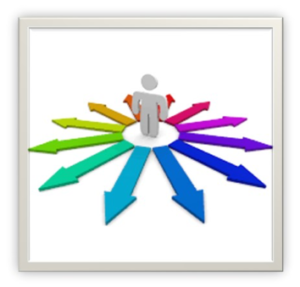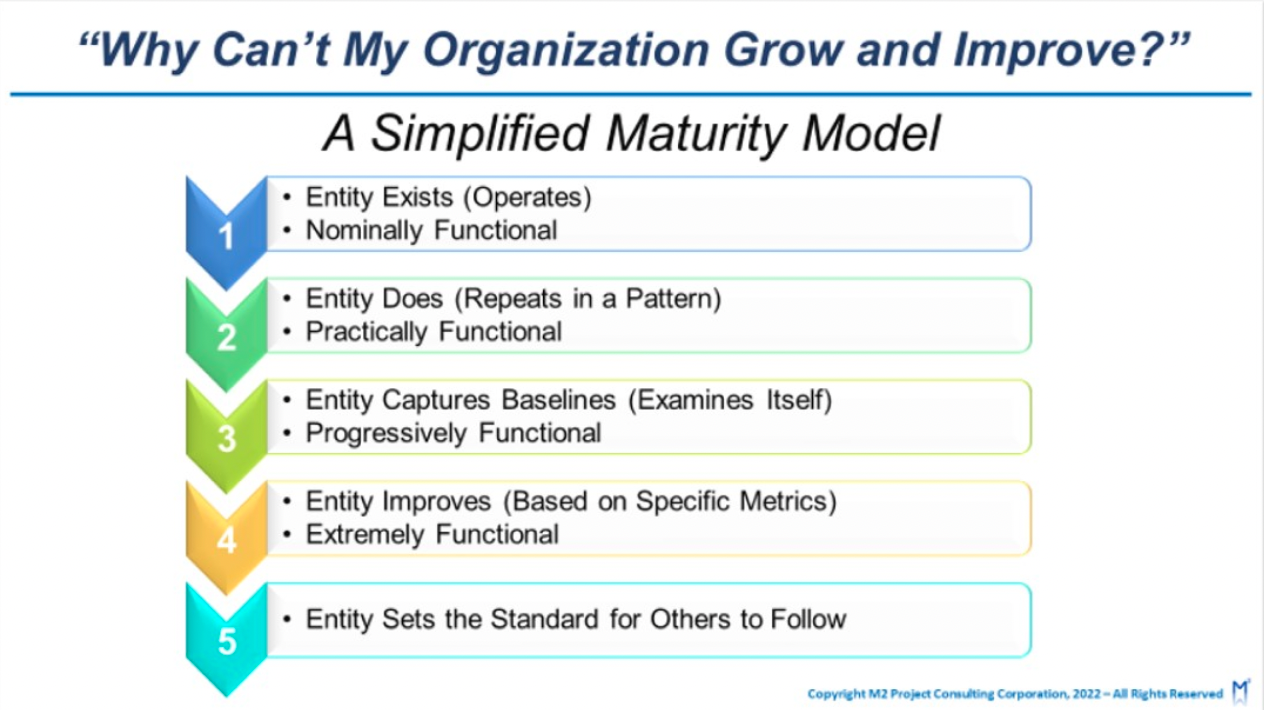 Many organizations get so caught up in what they currently do and how they do it, that they cannot find ways to effectively improve how they operate and experience the growth that stems from that kind of change. Plotting a path to organizational growth, especially based on the projects it chooses to execute, can be a challenge. The fundamental elements are not overly complicated, but the work to make the change is hard.
Many organizations get so caught up in what they currently do and how they do it, that they cannot find ways to effectively improve how they operate and experience the growth that stems from that kind of change. Plotting a path to organizational growth, especially based on the projects it chooses to execute, can be a challenge. The fundamental elements are not overly complicated, but the work to make the change is hard.
Stripping back the veneer of “pretend change” and finding how execution Value comes from properly communicated Vision and choices rooted in those fundamental elements often takes fresh eyes and a willingness to do things in a very different way. It can be a bit unnerving, but the alternative is stagnation.
Over time, we’ve developed this highly simplified maturity model as a reference to discuss how organizations can plot a path that moves them forward to higher levels of maturity. It borrows from what many of you will recognize as the current capability maturity models, but it isn’t intended to replace or supplant those (though several advisors who are well-versed in CMMI have reviewed it). It serves as a foundation to discuss where the organization is now and the possibilities that lie ahead if growth and improvement are desired. Ultimately, it’s as much about the journey (and the choices made along the way) as it is the destination.
Most maturity models break things down to five levels. The take we’re illustrating here does that as well. As you might expect, the basis (Level 1) has companies (and even individuals) functioning in what we’ve called a “Nominal” way. They are existing, they may well be profitable, and often that is fine. But if the goal is to grow and improve, something has to change. Choices have to be made; Current conditions and barriers (the last article’s topic) need to be identified; and a course to growth needs to be plotted.
The first move is getting to Level 2 – what we’ve termed Practically Functional entity. You’re developing metrics and verifying that you’ve met (or missed) them. The basic goal is to develop a predictable pattern and to repeat the good stuff that has brought you this far while jettisoning the baggage that would hold you back or revert you to a Nominally Functional entity. Nearly every organization can achieve this given some effort and rudimentary analysis. And, again, for many this is a satisfactory landing spot. However …
 If your goal is to continue moving up the maturity ladder and achieve a Level 3 or Level 4, the choices you make will become harder (not necessarily more “complicated” as we noted in the last article) and you need to evolve to a higher standard of metrics. The majority of what we consider “mature” organizations will hover around Level 3, or Progressively Functional. They will make great strides in their field. Their self-examination will yield results). But there will still be some barriers and challenges to overcome if they want to step up to that “magical” Level 4 status and become what we’ve termed Extremely Functional. We’ll talk more about that particular jump (and the others along the way) in the next article.
If your goal is to continue moving up the maturity ladder and achieve a Level 3 or Level 4, the choices you make will become harder (not necessarily more “complicated” as we noted in the last article) and you need to evolve to a higher standard of metrics. The majority of what we consider “mature” organizations will hover around Level 3, or Progressively Functional. They will make great strides in their field. Their self-examination will yield results). But there will still be some barriers and challenges to overcome if they want to step up to that “magical” Level 4 status and become what we’ve termed Extremely Functional. We’ll talk more about that particular jump (and the others along the way) in the next article.
One final thought on the maturity levels is for those extremely rare entities that achieve Level 5 and become the standard that others seek to emulate. There are a few out there; they are very rare. In most cases, trying to become one is best described as a Unicorn hunt … the idea of it is very exciting, but in reality, you probably won’t ever see one. Level 5’s tend to emerge as a by-product of who they are, the times in which they exist, and (quite frankly) a whole lot of luck. Sure, the founders had vision, but they rarely imagined how far it could take them.
To Change is to Choose … to Change
The road to hell is paved with good intentions (or so it’s been said). The road to change is paved with choices. Among the first choice an organization needs to make to effect growth and improvement is the choice to recognize the status quo isn’t going to get us where we want to be. That results in a choice to do something other than what we’re doing now. That choice will manifest itself in a myriad of ways and spawn a lot of other choices and decisions. You may need a trusted sounding board to help sift through the noise, but, ultimately, it has to begin with that fundamental element – ditch the status quo.
 You’ve doubtless read and heard a lot of material using the word “disruption”. In most cases, it’s a buzzword. It’s a “sexy term” that makes people feel like they are changing when all they are doing in most cases is creating more noise and adding to the already abundant inventory or confusion. Meaningful change will result in appropriate disruption, that much is certain. The choices you make to move into that change need to have a specific purpose in mind and they need to move you forward toward your Vision (we talked a bit about Vision in the last article and we’ll explore it more in future articles). It will probably result in some choices that need to be unwound and revisited, but that’s part of the growth process.
You’ve doubtless read and heard a lot of material using the word “disruption”. In most cases, it’s a buzzword. It’s a “sexy term” that makes people feel like they are changing when all they are doing in most cases is creating more noise and adding to the already abundant inventory or confusion. Meaningful change will result in appropriate disruption, that much is certain. The choices you make to move into that change need to have a specific purpose in mind and they need to move you forward toward your Vision (we talked a bit about Vision in the last article and we’ll explore it more in future articles). It will probably result in some choices that need to be unwound and revisited, but that’s part of the growth process.
One other aspect of your choice that needs consideration is more ingrained than just the status quo. It’s the conscious choice and effort to look beyond your immediate closed-loop system and explore options and factors outside of your immediate boundaries. Peter Senge, in his book “The Fifth Discipline”, spends the majority of a chapter walking the reader through the MIT Beer Game (well worth reading, if only for that portion). The essence of the Beer Game is a classic supply chain problem, brought on by the various players focusing only on what is right in front of them and never pulling back, looking outside of their immediate closed-loop systems, and making bad choices that have broad and lasting impacts. Substantive, sustainable change that leads to growth and improvement will require you take that approach. As we stated before, it isn’t complicated … but the work is often hard. And that can easily turn an organization back to the status quo.
But Wait! There’s More!
We’ve briefly discussed a simplified organizational maturity model and how change requires a choice. Starting down the path of choice will breed other choices. Yet it is the most fundamental element of change necessary to move an organization forward.
In the next article, we’ll take our simplified maturity model and explore some of the steps required to begin your journey upward. Then we’ll discuss some of the practical aspects of examining an organization and setting up a strong foundation for the kind of change that makes that happen. We hope you’ll join us and provide some feedback as we walk through this series of articles and find out what sustainable change can mean for individuals and organizations.
BIO:
Mark Moore, M2PCC’s Executive Consultant, is an experienced leader and communicator, with a long track record of successful program and project management, training development and delivery, and transformational change. He brings over three decades of experience spanning multiple industries and disciplines. His focus on delivery of Value aligned with Vision lies at the heart of FLOW and organizational transformation.
Executive Consultant
mark@m2projectconsultingcorp.com
919.724.3679

